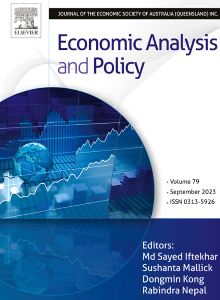Industrial relocation or shorter shipping routes? Examining the impact of the EU’s carbon border adjustment mechanism on global emissions using structural gravity
IF 8.7
2区 经济学
Q1 ECONOMICS
引用次数: 0
Abstract
To address concerns over carbon leakage, the European Union (EU) has announced the introduction of a Carbon Border Adjustment Mechanism (CBAM), which started in October 2023. Using trade data for the year 2014, this study applies a structural gravity model to simulate the impact of CBAM on welfare, production, exports and emissions. Our main contribution is to include emissions from shipping activities into the structural gravity model, in addition to production, to offer a more comprehensive assessment of the CBAM’s environmental effect. Our results show that, while CBAM would have little effect on welfare, the policy would contribute to a reduction in exports, estimated between -0.29 % (metal products) and -1.49 % (iron and steel). In particular, we find that middle income economies are most affected by the policy, and that these countries tend to greatly reduce their exports to the EU. We also observe a rebound in production (and associated emissions) among the EU economies. Nevertheless, by including emissions from shipping activities, we find that CBAM would have resulted in a large amount of emission decrease, most of which is due to export reduction.
工业搬迁还是更短的航运路线?利用结构重力分析欧盟碳边界调整机制对全球排放的影响
为了解决对碳泄漏的担忧,欧盟(EU)宣布引入碳边界调整机制(CBAM),该机制将于2023年10月启动。本文利用2014年的贸易数据,运用结构引力模型模拟了CBAM对福利、生产、出口和排放的影响。我们的主要贡献是将运输活动的排放纳入结构重力模型,除了生产之外,还提供了对CBAM环境影响的更全面评估。我们的结果表明,虽然CBAM对福利几乎没有影响,但该政策将有助于减少出口,估计在- 0.29%(金属产品)和- 1.49%(钢铁)之间。特别是,我们发现中等收入经济体受该政策的影响最大,这些国家往往会大大减少对欧盟的出口。我们还观察到欧盟经济体的生产(及相关排放)出现反弹。然而,通过纳入航运活动的排放,我们发现CBAM将导致大量的排放减少,其中大部分是由于出口减少。
本文章由计算机程序翻译,如有差异,请以英文原文为准。
求助全文
约1分钟内获得全文
求助全文
来源期刊

Economic Analysis and Policy
ECONOMICS-
CiteScore
9.80
自引率
9.20%
发文量
231
审稿时长
93 days
期刊介绍:
Economic Analysis and Policy (established 1970) publishes articles from all branches of economics with a particular focus on research, theoretical and applied, which has strong policy relevance. The journal also publishes survey articles and empirical replications on key policy issues. Authors are expected to highlight the main insights in a non-technical introduction and in the conclusion.
 求助内容:
求助内容: 应助结果提醒方式:
应助结果提醒方式:


